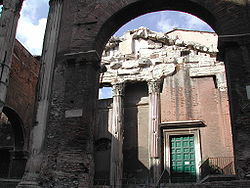
Sant'Angelo in Pescheria
Encyclopedia

Churches of Rome
There are more than 900 churches in Rome. Most, but not all, of these are Roman Catholic, with some notable Roman Catholic Marian churches.The first churches of Rome originated in places where Christians met. They were divided into three categories:...
Rome
Rome
Rome is the capital of Italy and the country's largest and most populated city and comune, with over 2.7 million residents in . The city is located in the central-western portion of the Italian Peninsula, on the Tiber River within the Lazio region of Italy.Rome's history spans two and a half...
. It dates from the 8th century. "In Pescheria" refers to its location close to the fish market
Fish market
A fish market is a marketplace used for marketing fish products. It can be dedicated to wholesale trade between fishermen and fish merchants, or to the sale of seafood to individual consumers, or to both...
built in the ruins of the ancient Porticus Octaviae
Porticus Octaviae
The Porticus Octaviae is an ancient structure in Rome.Built by Augustus in the name of his sister, Octavia Minor, at some time after 27 BC, in place of the Porticus Metelli, the porticus enclosed within its colonnaded walks the temples of Jupiter Stator and Juno Regina, next to the Theater of...
.
The relics of St. Symphorosa and her seven sons were transferred to the Church of Sant'Angelo in Pescheria at Rome by Pope Stephen II
Pope Stephen II
Pope Stephen II was Pope from 752 to 757, succeeding Pope Zachary following the death of Pope-elect Stephen. Stephen II marks the historical delineation between the Byzantine Papacy and the Frankish Papacy.-Allegiance to Constantinople:...
in 752. A sarcophagus
Sarcophagus
A sarcophagus is a funeral receptacle for a corpse, most commonly carved or cut from stone. The word "sarcophagus" comes from the Greek σαρξ sarx meaning "flesh", and φαγειν phagein meaning "to eat", hence sarkophagus means "flesh-eating"; from the phrase lithos sarkophagos...
was found here in 1610, bearing the inscription: Hic requiescunt corpora SS. Martyrum Simforosae, viri sui Zotici (Getulii) et Filiorum ejus a Stephano Papa translata. This inscription refers to Saint Getulius and Saint Symphorosa, purported to be husband and wife, who had seven sons, who were also martyred. The remains of these saints were transferred to Sant'Angelo by Pope Stephen II
Pope Stephen II
Pope Stephen II was Pope from 752 to 757, succeeding Pope Zachary following the death of Pope-elect Stephen. Stephen II marks the historical delineation between the Byzantine Papacy and the Frankish Papacy.-Allegiance to Constantinople:...
in 752.
The revolutionary "tribune" Cola di Rienzo
Cola di Rienzo
Cola di Rienzo was an Italian medieval politician and popular leader, tribune of the Roman people in the mid-14th century.-Early career:Cola was born in Rome of humble origins...
was born near Sant'Angelo. He launched his effort to seize control of Rome from the vicinity of the church in 1347.
The Roman Ghetto
Roman Ghetto
The Roman Ghetto was a ghetto located in the rione Sant'Angelo, in Rome, Italy, in the area surrounded by today's Via del Portico d'Ottavia, Lungotevere dei Cenci, Via del Progresso and Via di Santa Maria del Pianto close to the Tiber and the Theater of Marcellus...
was established nearby in the rione
Rione
Rione is the name given to a ward in several Italian cities, the best-known of which is Rome. Unlike a quartiere, a rione is usually an official administrative subdivision...
Sant'Angelo in 1555 by order of Pope Paul V
Pope Paul V
-Theology:Paul met with Galileo Galilei in 1616 after Cardinal Bellarmine had, on his orders, warned Galileo not to hold or defend the heliocentric ideas of Copernicus. Whether there was also an order not to teach those ideas in any way has been a matter for controversy...
. The Ghetto was abolished in 1870 after the reunification of Italy or Risorgimento, and the Ghetto wall was demolished in 1888. The rione Sant'Angelo, Rome, numbered as XI, is named for the church.
In the second chapel to the left inside the church are frescoes of the Madonna with Child and Angels attributed to Benozzo Gozzoli
Benozzo Gozzoli
Benozzo Gozzoli was an Italian Renaissance painter from Florence. He is best known for a series of murals in the Palazzo Medici-Riccardi depicting festive, vibrant processions with wonderful attention to detail and a pronounced International Gothic influence.-Apprenticeship:He was born Benozzo di...
(c. 1450).

